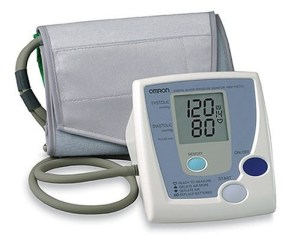Home blood pressure monitoring is important in the diagnosis and management of high blood pressure (hypertension). Self monitoring helps monitor your blood pressure within a comfortable and familiar setting.
This allows your physician and you to know whether your blood pressure is under control or how well your blood pressure medication is working.
Home blood pressure monitoring helps in the early prevention of potential health complications.
Who needs to be doing this?
Home blood pressure monitoring is particularly useful in clinical situations including:
-
- Borderline hypertension
- Newly diagnosed hypertension
- Variable blood pressure readings in the office or wide blood pressure discrepancy between home and doctors office (white coat hypertension)
- Apparentresistance to blood pressure medication
- Hypotensive symptoms from medications
- Suspected autonomic dysfunction
- Episodic hypertension
- Prognostic data
Why do I need it?
Since blood pressure fluctuates throughout the day, multiple recordings need to be taken. Readings can vary throughout the day and can be triggered by emotions, diet, or medications. Multiple blood pressure readings give a more accurate range of what your actual blood pressure is oppose to your clinical office visits.
Blood pressure recording in a comfortable and familiar surrounding helps to eliminate emotional stress or anxiety some patients may have after walking into a doctor’s office.
Blood pressure monitoring can help in a personal self improvement for controlling blood pressure. Most patients become encouraged and better motivated about their own health with a home monitoring system.
Who should not be doing this?
For patients with an irregular heartbeat (arrhythmia), home blood pressure monitoring is not advised.
This is because home monitoring does not give accurate readings in these patients.
What is the risk?
There are no known risks associated with home blood pressure monitoring.
A temporary and brief squeezing or sensation of tingling and numbness may be felt during the inflation of the cuff.
How is it done?
For the diagnosis of hypertension, multiple readings should be taken at various times throughout a patient’s day in addition to regular monitoring at the physicians office.
Blood pressure should be measured twice daily, at the same time everyday. Blood pressure should be measured once in the morning about one hour after waking and before taking your medications or foods. An evening blood pressure can be taken before dinner and before your evening medications.
Avoid caffeine, tobacco, and food 30 minutes before recording your blood pressure. Make sure to be seated, comfortable, and relaxed before taking your blood pressure. Avoid speaking while taking your blood pressure.

The correct method to check blood pressure is to place the cuff over your Left arm about 2cms above the elbow. Place the lined marking on the cuff against the artery of the inner arm, on the inside area of the biceps muscle. The cuff should not be too tight or too loose. Two fingers should be able to pass beneath the cuff. Turn the machine on and the cuff will automatically inflate.
It is important to make a diary of your activities. Normal daily activities including exercise, eating, sleeping, and even when you take your daily medications must be noted. Record the time of day or any symptoms you may feel accurately in your diary.
Bring your diary with you to your next appointment so your physician can assess how well your blood pressure is controlled.
Interpretation:
Interpreting your blood pressure readings may be confusing. The top number, Systolic pressure is the pressure in the arteries during contraction of the heart when arteries are being filled with blood. The bottom number is the Diastolic pressure which measures the pressure within the arteries during the relaxation of the heart resulting in a lower value than the top number.
Normal blood pressure ranges up to 120/80, but blood pressure can rise and fall with exercise, rest, or emotions.
| Systolic Pressure | Diastolic Pressure | |
| Normal | <120 | <80 |
| Prehypertension | >120-139 | 80-89 |
| Essential (primary) Hypertension | 140-159 | 90-99 |
| Secondary Hypertension | >160 | >100 |
If the presence of hypertension has been made, the following information should be assessed:
-
- The presence and extent of target organ damage
- The cardiovascular risk status
- Rule out other possible and reversible causes of hypertension
What are the benefits?
Several benefits of home blood pressure monitoring include:
-
- Establishment of true vs. false hypertension (i.e. White coat hypertension)
- Assess the response to blood pressure medications
- Patient compliance improvement
- Possible reduction in health care costs
